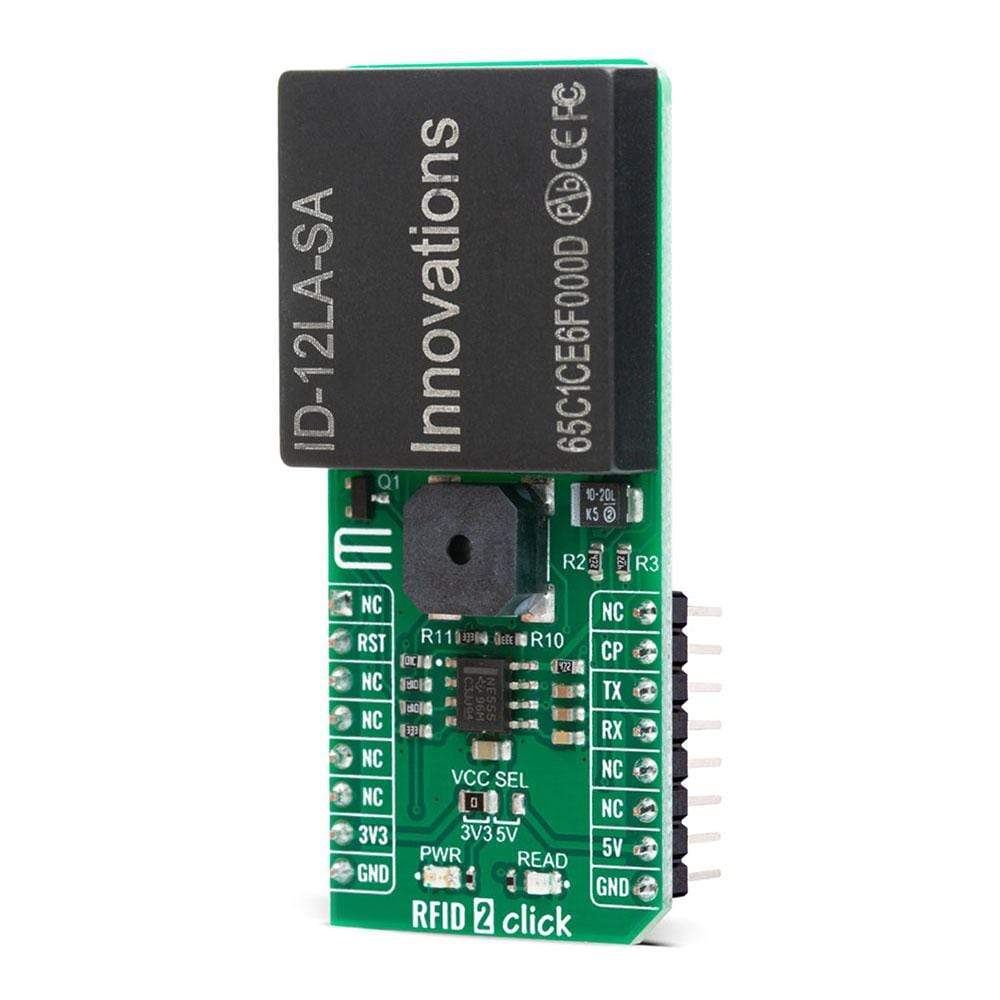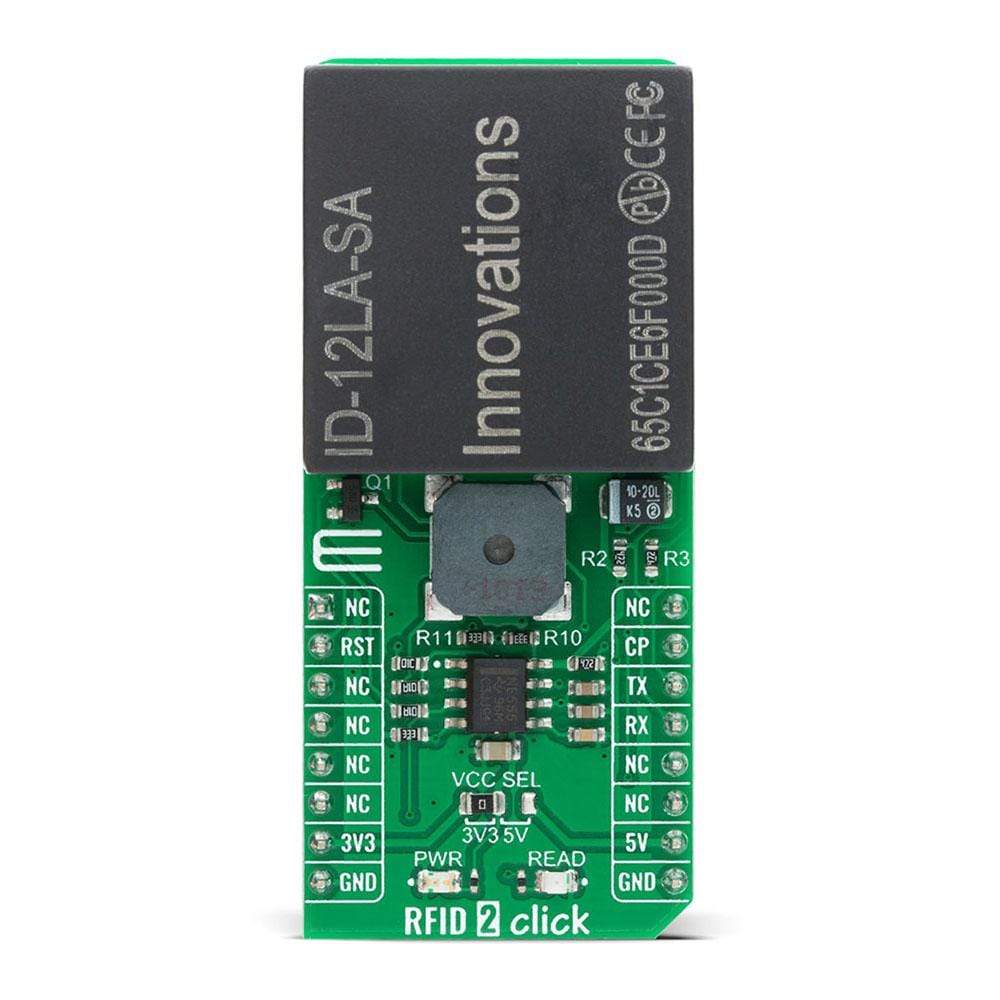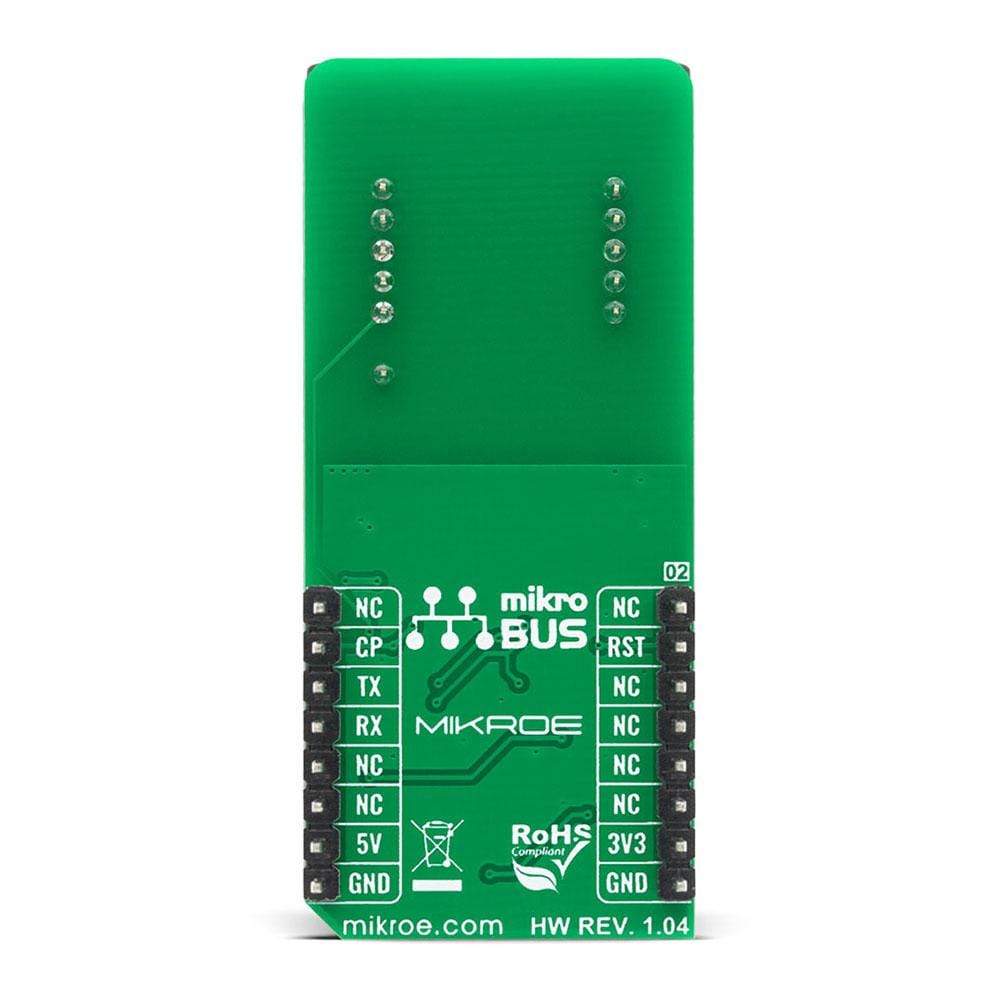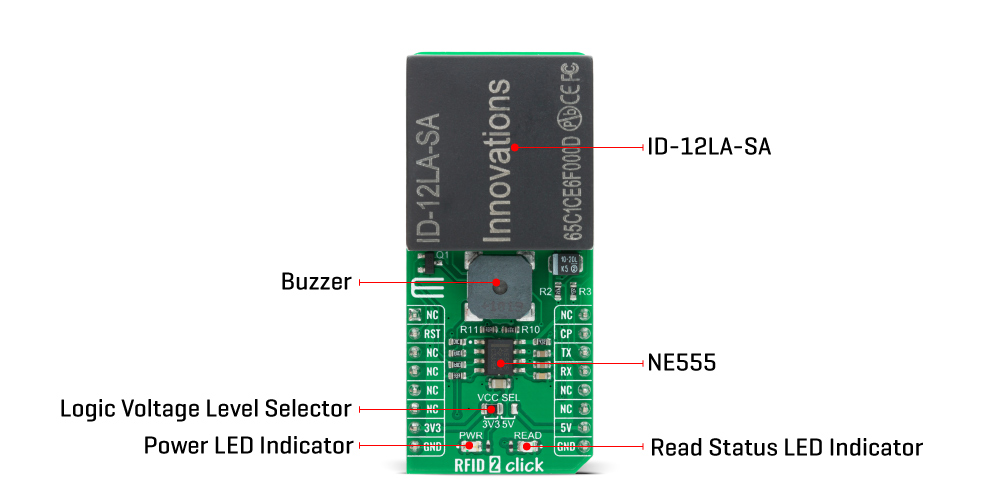


Overview
The RFID 2 Click Board™ is a compact add-on board that contains a stand-alone RFID reader with a built-in antenna easy-to-use for embedded applications. This board features the ID-12LA-SA, an advanced low-cost RFID reader module usable with 38 different tags from ID Innovations. This small 125kHz reader has a 9600bps TTL/RS232 output with Magnetic, Wiegand, or ASCII format, read ranges of 12cm and 18cm and possesses a remotely controlled channel that can be used to operate with user peripherals. This Click Board™ is designed to be used in stand-alone or remote-controlled applications to identify and track tags attached to objects.
The RFID 2 Click is supported by a mikroSDK compliant library, which includes functions that simplify software development. This Click Board™ comes as a fully tested product, ready to be used on a system equipped with the mikroBUS™ socket.
Downloads
How Does The RFID 2 Click Board™ Work?
The RFID 2 Click Board™ is based on the ID-12LA-SA, an advanced low-cost RFID reader module designed to be used in stand-alone or remote-controlled applications to identify and track tags attached to objects from ID Innovations. The ID-12LA-SA requires the supply voltage up to 5V, supports normal mode (autonomous mode) of operation, incorporates internal antennas, and has read ranges of 12cm and 18cm.

In normal mode, when a card is presented to the reader, the reader search up for the card in its EEROM memory (the EEROM area stores the password and the reader polling address as well as timing and other values), and if there is a match module sends feedback information through interrupt pin labeled as CP. This mode automatically ceases to operate if the reader module detects a valid polled command. It is crucial to mention the safety fact that provides protection in such a way that the reader requires a password authorization for system changes and addition or removal of cards. In this way, the EEROM can be made safe and can only be restored with the password.
The ID-12LA-SA module communicates with MCU using the UART interface that operates at 9600 bps by default configuration with commonly used UART RX and TX pins for data transfer. The ID-12LA-SA module sends the ID data to the TX UART pin for monitoring, and in Normal mode, the reader sends the ID data of every card that it reads. Additional functionality, as mentioned previously in the product description, such as Reset and 'Card Present' interrupt is provided and routed at RST and INT pins of the mikroBUS™ socket labeled as RST and CP.
The RFID 2 Click Board™ also features the CMT-8540S-SMT magnetic buzzer that sounds for approximately one second when a card is detected, controlled by the NE555 precision timer capable of producing highly accurate time delays from Texas Instruments. Signal frequency determines the sound pitch, and the duty cycle determines the amplitude (sound volume), so the user is left with the option of creating a sound pattern of their choice. It also possesses the card read status LED indicator labeled as READ that indicates a successful detection of ID card.
The RFID 2 Click Board™ is designed to be operated with both 3.3V and 5V logic voltage levels that can be selected via VCC SEL jumper. This allows for both 3.3V and 5V capable MCUs to use the UART communication lines properly. However, the Click board™ comes equipped with a library that contains easy to use functions and an example code that can be used as a reference for further development.
SPECIFICATIONS
| Type | RFID/NFC |
| Applications | Can be used in stand-alone or remote-controlled applications to identify and track tags attached to objects. |
| On-board modules | The RFID 2 Click Board™ is based on the ID-12LA-SA, an advanced low-cost RFID reader module designed to be used in stand-alone or remote-controlled applications to identify and track tags attached to objects from ID Innovations. |
| Key Features | Low power consumption, autonomous mode, remote controlled auxiliary Channel, long range 12cm and 18cm, and more. |
| Interface | UART |
| Compatibility | mikroBUS |
| Click board size | L (57.15 x 25.4 mm) |
| Input Voltage | 3.3V or 5V |
PINOUT DIAGRAM
This table shows how the pinout on the RFID 2 Click Board™ corresponds to the pinout on the mikroBUS™ socket (the latter shown in the two middle columns).
| Notes | Pin |  |
Pin | Notes | |||
|---|---|---|---|---|---|---|---|
| NC | 1 | AN | PWM | 16 | NC | ||
| Reset | RST | 2 | RST | INT | 15 | CP | Card Present Interrupt |
| NC | 3 | CS | RX | 14 | TX | UART TX | |
| NC | 4 | SCK | TX | 13 | RX | UART RX | |
| NC | 5 | MISO | SCL | 12 | NC | ||
| NC | 6 | MOSI | SDA | 11 | NC | ||
| Power Supply | 3.3V | 7 | 3.3V | 5V | 10 | 5V | Power Supply |
| Ground | GND | 8 | GND | GND | 9 | GND | Ground |
ONBOARD SETTINGS AND INDICATORS
| Label | Name | Default | Description |
|---|---|---|---|
| LD1 | PWR | - | Power LED Indicator |
| LD2 | READ | - | Read Status LED Indicator |
| JP1 | VCC SEL | Left | Power Supply Voltage Selection 3V3/5V: Left position 3V3, Right position 5V |
| PZ1 | BUZZER | - | Magnetic Buzzer Transducer |
RFID 2 CLICK ELECTRICAL SPECIFICATIONS
| Description | Min | Typ | Max | Unit |
|---|---|---|---|---|
| Supply Voltage | +3 | - | +5.4 | V |
| Maximum Output Current | -5 | - | +5 | mA |
| Read Range | 12 | - | 18 | cm |
| Frequency | - | 125 | - | kHz |
| Operating Temperature Range | -10 | - | +50 | °C |
| General Information | |
|---|---|
Part Number (SKU) |
MIKROE-4208
|
Manufacturer |
|
| Physical and Mechanical | |
Weight |
0.026 kg
|
| Other | |
Country of Origin |
|
HS Code Customs Tariff code
|
|
EAN |
8606027380853
|
Warranty |
|
Frequently Asked Questions
Have a Question?
Be the first to ask a question about this.



